The IET has a strong history of presenting lectures and papers, not only to its members but also to the public. Looking back at the Institution’s original aims to bring people and ideas together, to inform and influence, it is evident that lectures are a main component of what the IET does.
At the forefront of innovation
Ever since the earliest days of the Institution eminent scientists have presented their discoveries to like-minded individuals which were discussed at length in mutual exchanges of ideas.
Back in 1877 Alexander Graham Bell gave a lecture to the Society of Telegraph Engineers entitled, ‘Researches in Electric Telephony’ and Joseph Swan gave a lecture on ‘The subdivision of the electric light’ in 1885.
In addition to lectures, papers were read at Ordinary General Meetings of the Society at fortnightly intervals which were published in the Journal.
An early example of such a paper can be seen in 1873 at the Twelfth Ordinary General Meeting, where Willoughby Smith presented his research on the photoconductivity of selenium; a technology which later led to early television cameras and solar cells.
In June 1872 the Society of Telegraph Engineers held the first of their conversaziones which also included an exhibition. It was held in a laboratory in Greek Street, London, which belonged to Lord Lindsay. His large electro-magnet was displayed alongside a collection of electrical and telegraphic apparatus.
In addition to the exhibitions, light refreshments and musical accompaniment were provided, often by the string band of the Royal Engineers.
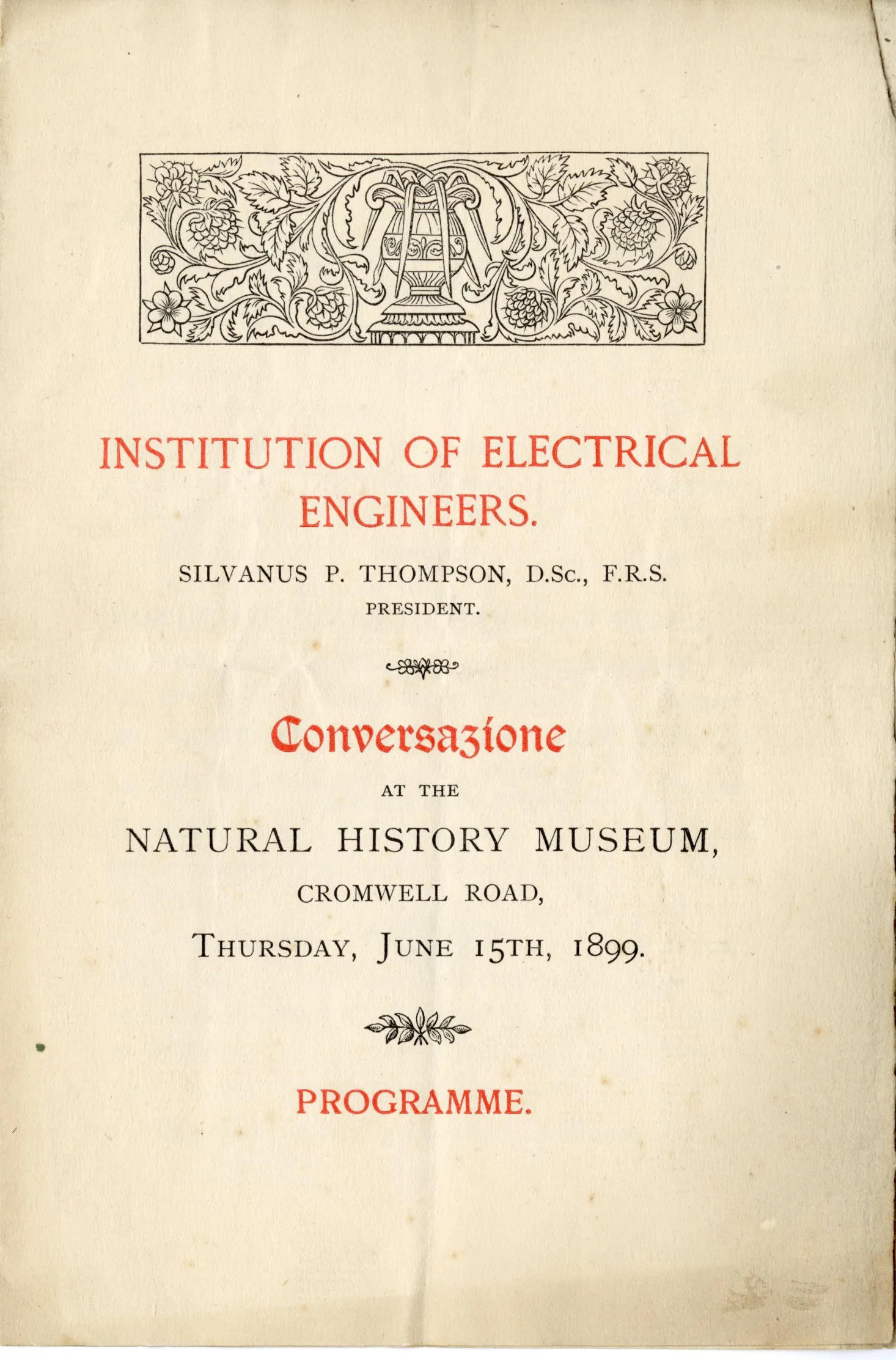
IEE Conversazione programme from 1899
The aim to convene for the exchange of information and ideas penetrated every meeting and these grew steadily in size and stature. During the session of 1921-1922 there were 207 meetings when the membership was around 10,000. The following decade this rose to 262 in 1930-1931 with 14,000 members. By 1938-1939 there were 320 with 19,000 members and 158 of these meetings were held at local centres and sub-centres. Power engineering subjects dominated at the Ordinary Meetings during the 1920s and 1930s with the main focus on the generation, distribution and use of electric power.
The subjects discussed in later Presidential Addresses demonstrates the key recurring subjects over power supply (1976), television and broadcasting (1970s and 1980s), electricity supply and distribution (1980s and 1990s) and engineering education (1980s and 1990s).
Danielle George, IET President 2020-2021, gave her presidential address on difference makers – celebrating those who have had a massive impact on the world around us and continue to inspire the next generation of engineers.
Big names – Big ideas
Since the inception of the lectures the Institution has hosted some of the world’s most eminent scientists, engineers and inventors which has led to accomplishments that have changed the way we live and work forever.
Looking through the records from the first 75 years of our history it affords a glimpse of some of the great names in STEM that the Institution has hosted which has led to accomplishments that have changed the way we live and work forever.
In 1872 James Clerk Maxwell read a paper ‘On the induction of electric current in an infinite plane sheet of uniformly conducting matter’. To understand the significance of hearing Maxwell one must understand how important his discoveries were. They helped usher in the age of modern physics and laid the foundation for such fields as special relativity and quantum mechanics. Maxwell’s quantitative connection between light and electromagnetism is considered one of the great accomplishments of 19th century mathematical physics.
In 1878 Sir William Preece demonstrated the Edison Phonograph. The phonograph was a device invented by Thomas Edison for the playing and recording of sound and heralded a new era in sound technology. A letter in the IET Archives gives detailed instructions to Preece on how to operate the phonograph for this lecture.
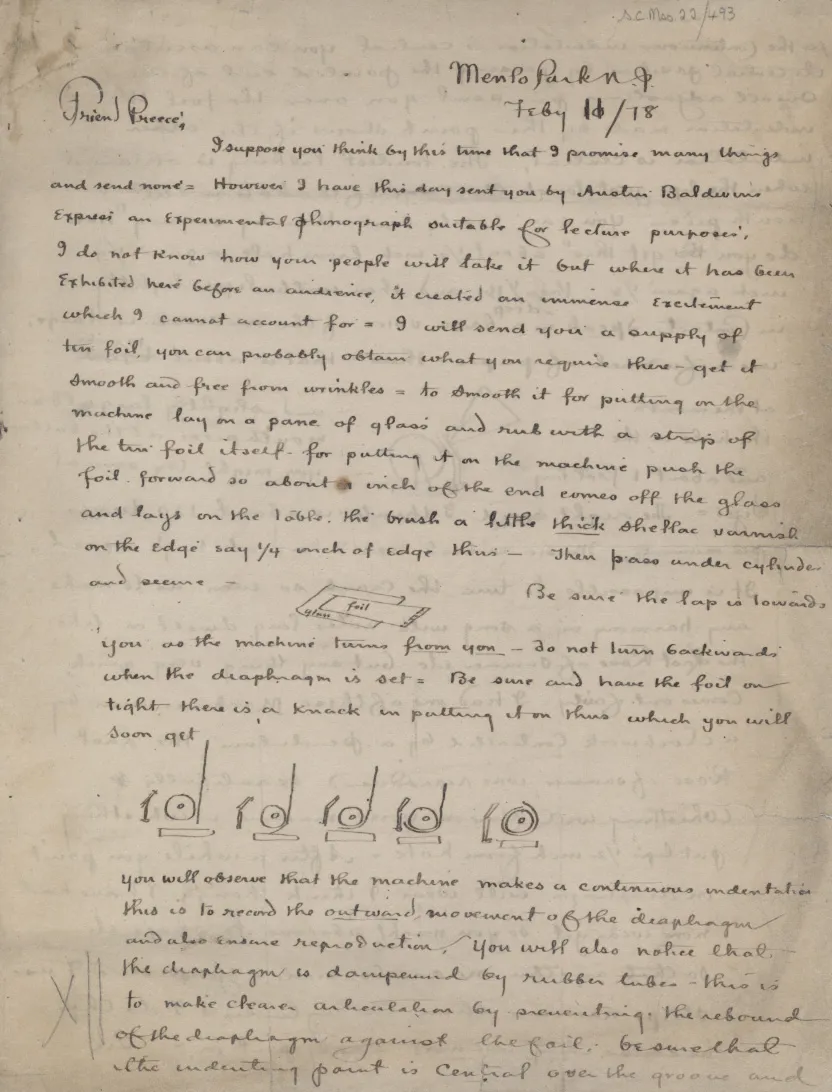
Letter from Thomas Edison to William Preece page 1 ref. IET Archives SC MSS 022/VI/493
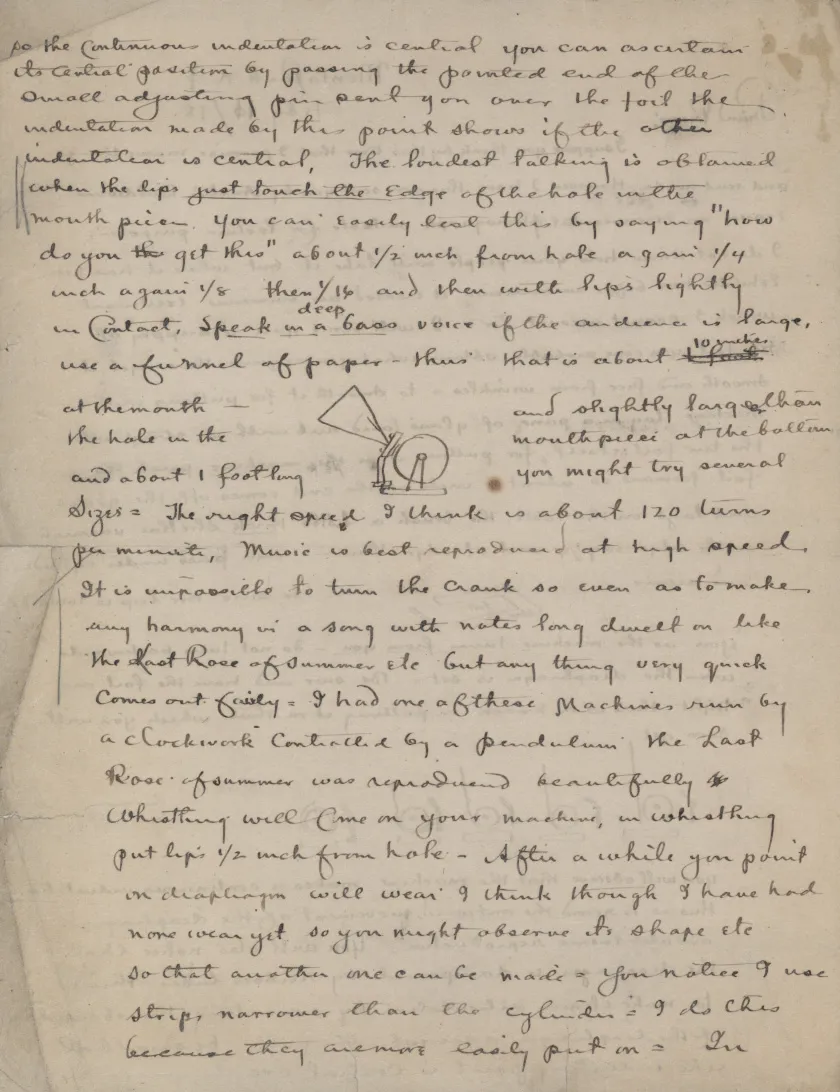
Letter from Thomas Edison to William Preece page 2 ref. IET Archives SC MSS 022/VI/493
In 1881 J J Thomson, physicist and Nobel Laureate in Physics, credited with the discovery of the electron, presented his paper on ‘On the electric and magnetic effects produced by the motion of electrified bodies’.
In 1889 Hertha Ayrton, engineer, mathematician, physicist, inventor, and suffragette, was the first woman to present a paper to the IEE, on the subject of the hissing in arc lamps, a problem she solved.
In the same year, she was elected as the first woman member of the IEE.
In 1899 Guglielmo Marconi, inventor and electrical engineer, credited as the inventor of radio and pioneer in long-distance radio transmission presented a paper to the Institution on ‘Wireless Telegraphy’. He later shared the Nobel Prize in Physics in recognition of his contributions to this field in 1909.
In 1920 Captain Harry Joseph Round, personal assistant to Marconi, who’s observations led to the discovery of the light-emitting diode, presented his paper ‘Direction and position finding’ (foundations of radar) to the Institution.
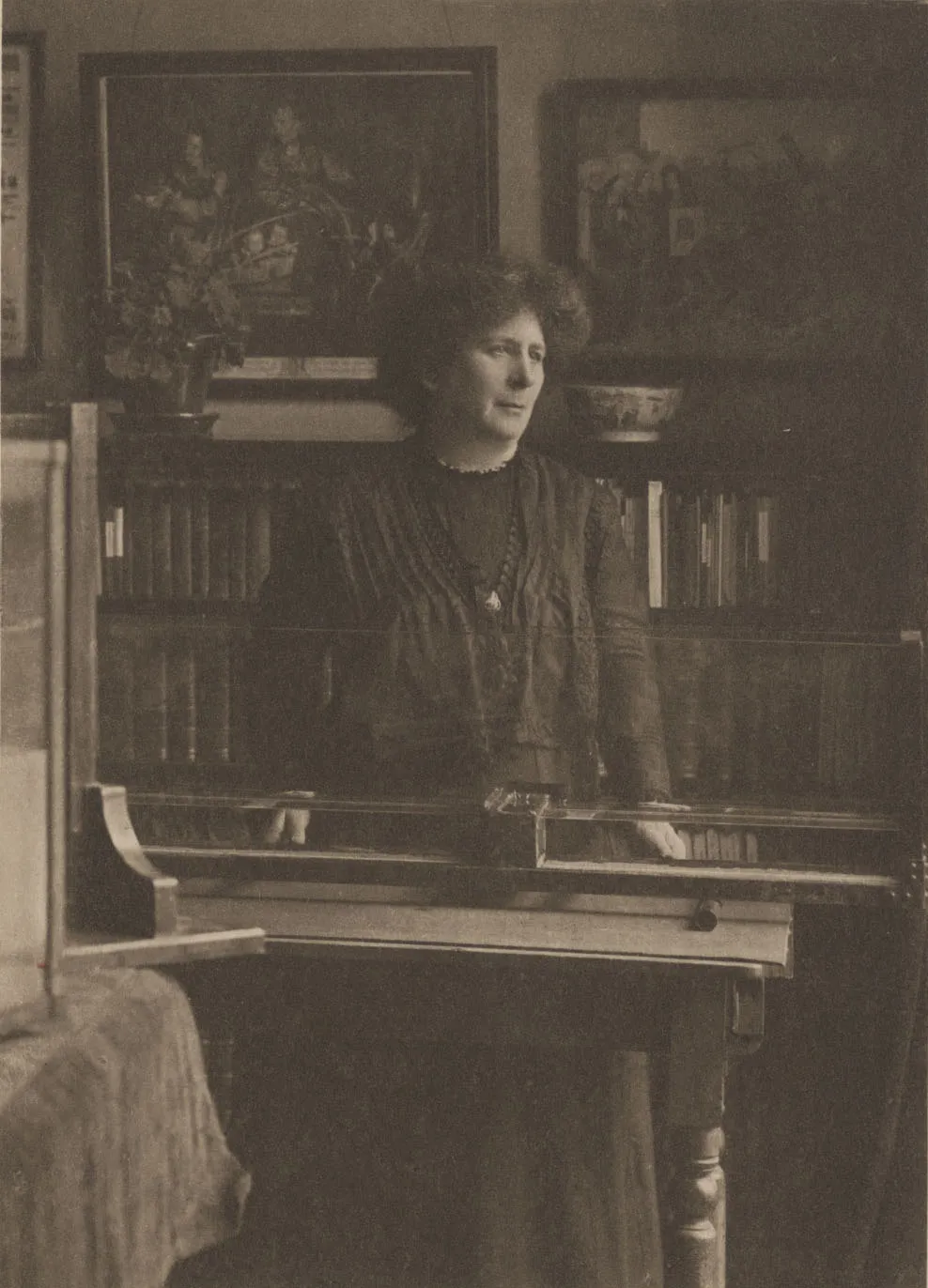
Hertha Ayrton in her laboratory
During the First World War, Round set up a series of direction-finding stations along the Western Front for which he was awarded the Military Cross in 1918.
In 1921 W H Eccles and (Miss) W A Leyshon presented a paper on ‘Thermionic tube circuits’. Eccles was a notable radio pioneer and an early associate of Marconi. In 1912 Eccles suggested that solar radiation was responsible for the observed differences in radio wave propagation during the day and night.
During the First World War, Eccles acted as advisor to the War Office, the Army Council, the wireless technical committee of the Air Force, and the Admiralty. In 1926 he became President of the IEE. Miss W A Leyshon was a member of the Physical Science Society at Bedford College.
In 1928 P P Eckersley presented his paper on ‘The design and distribution of wireless broadcasting stations for a national service’. Eckersley was a pioneer of British broadcasting, the first Chief Engineer of the British Broadcasting Company Limited from 1922 to 1927 and Chief Engineer of the British Broadcasting Corporation until 1929.
A year later in 1929 Sebastian Ziani de Ferranti presented his paper on ‘Electricity in the service of man’.
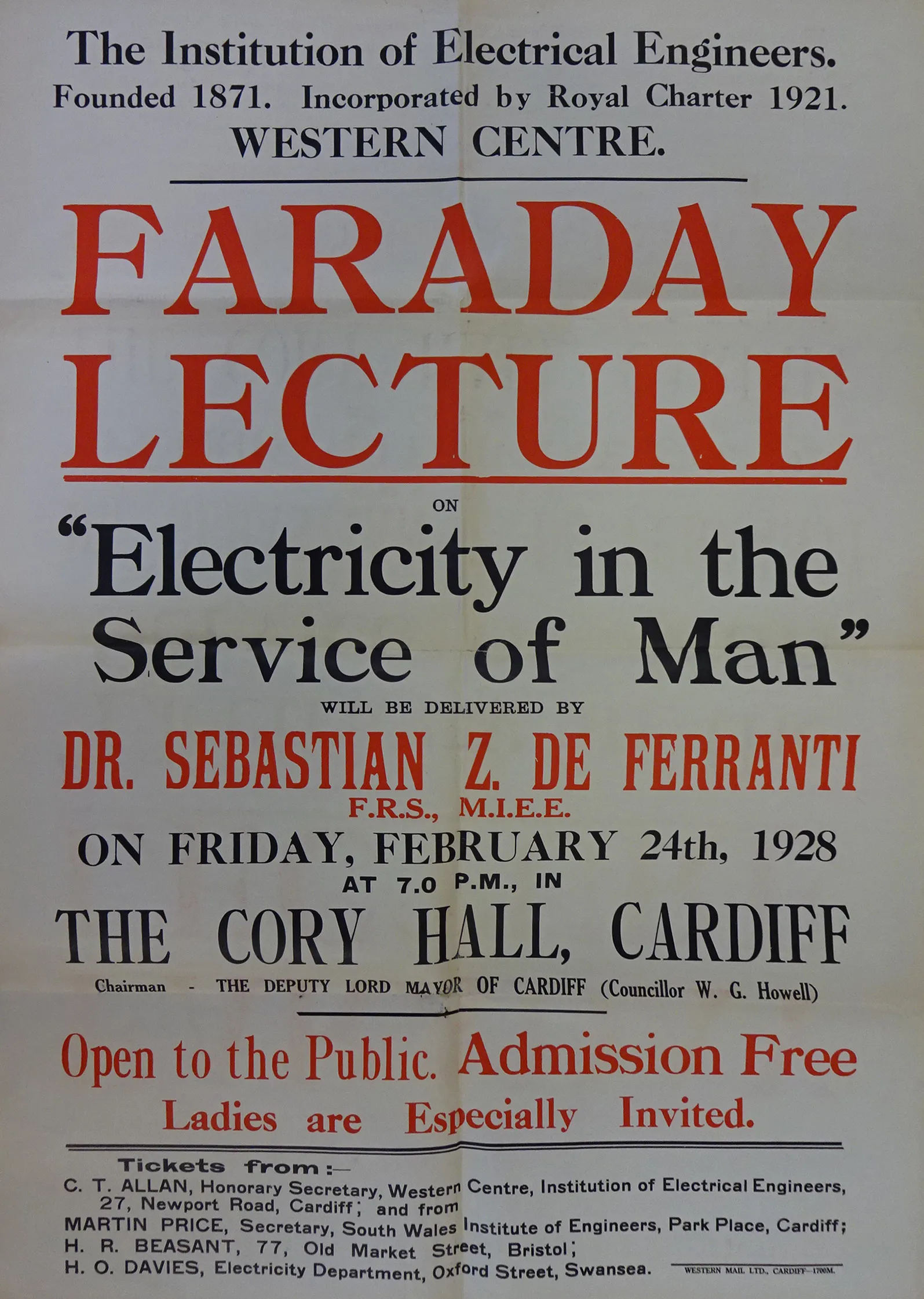
Faraday Lecture poster 1928 ref. IET Archives IET/LEC/01/40
Interestingly the poster in the IET Archives shows how inclusive the Institution was with the line ‘Ladies are especially invited.’
In 1932 Sir Edward Appleton presented a paper on ‘Wireless studies of the ionosphere’. Sir Edward Appleton, a widely honoured physicist and Nobel Prize winner, is noted for his research into the upper atmosphere.
In 1939 Alan D Blumlein delivered his paper on ‘The Marconi EMI television system’. Blumlein made a major contribution to radar development during the Second World War.
Prior to this, he made significant contributions to recording and television, including a system of stereo recording. This was then adapted to develop an acoustic direction finder for aircraft, and he worked on aircraft radar systems.
In 1941 Winifred Hackett and A M Thomas presented a paper on ‘The electric strength of mica and its variation with temperature’ (Miss Hackett was awarded £25 and £50 from the War Thanksgiving Fund in 1930 and 1931 while at Birmingham University).
She later became President of The Women’s Engineering Society 1946-1947.
In 1946 the first convention on radiolocation was held after the Second World War. The magnitude of this event is perfectly summed up by Dr P Dunsheath, President of the IEE in his opening address:
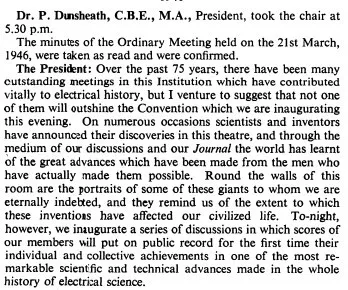
The technical introduction was given by Sir Robert Watson-Watt. The principle speaker was the Minister of Supply, the Rt. Hon. John Wilmot who said “It is, of course, an outstanding tribute to this Institution that it is at your Convention that these remarkable discoveries are to be made known.”
Standing on the shoulders of giants
The Institution’s lectures seek to challenge, provoke, excite and advance. The many lectures offered by the IET demonstrates the variety of subjects covered. General subjects over the years have included telegraphy, electric lighting, electricity supply, broadcasting, domestic electricity, telecommunications, atoms and electrons, radar, railways, medicine, navigation, satellites, computers, robotics, nuclear power to name but a few.
Most recently the IET has initiated their EngTalks, which were previously known as the Prestige Lectures, named after or in honour of influential individuals. The EngTalks cover the big engineering and technology topics of today, delivered by inspirational personalities passionate about influencing and informing their peers and the next generation of engineers. The EngTalks are free to attend and open to everyone.
The EngTalks encompass the previously named lectures:
- The Appleton Lecture - established in 1967 to commemorate the life and work of Sir Edward Appleton, a widely honoured physicist and Nobel Prize winner, noted for his research into the upper atmosphere. It now forms part of the IET EngTalks series on Communication
- The Mountbatten Lecture - established in 1978 by the National Electronics Council. The first lecture was delivered by Lord Mountbatten. After his assassination the following year it was renamed the Mountbatten Memorial Lecture in his honour. It now forms part of the IET EngTalks series on Electronics.
- The Turing Lecture - established in 1998, is held in partnership with the British Society of Computing. Alan Turing was an English mathematician, computer scientist and wartime codebreaker, considered the ‘father of modern computing’. This EngTalk forms the series on Computing.
- The Kelvin Lecture - the IET’s longest-standing lecture. It was founded in 1908 as a memorial to William Thomson, Lord Kelvin three times President of the IEE. The first Kelvin Lecture was given by IEE Past President Silvanus P Thompson on 30 April 1908, on The Life and Work of Lord Kelvin.
- Nuffield Lecture - named after William Richard Morris, 1st Viscount Nuffield. This lecture is in his honour, a man who overcame a World War and bankruptcy to create one of the world’s largest automotive manufacturing companies in the world. It forms the EngTalk series on Manufacturing.
- James Clerk Maxwell Lecture - named after the Scottish physicist who was responsible for revolutionary work in electromagnetism and the kinetic theory of gases. Maxwell’s extension of Michael Faraday’s mathematical formulation of electromagnetic theory and magnetic lines of force, known as Maxwell’s equations. It forms the EngTalk series on Power.
- The Sir Henry Royce Memorial Lecture - inspired by the life and work of Sir Frederick Henry Royce, one of the finest mechanical engineers in UK history. The first lecture was organised in 1992 by the Institution of Incorporated Engineers (IIE), in association with the Sir Henry Royce Memorial Foundation. Initially run biannually it is now given annually, as part of the IET EngTalks lecture series.
From 1945 onwards the Institution was ambitious in its activities as a learned society. Its members were catered for with the reading and discussion of papers but to attract a more general ‘learned’ audience they looked towards the long-established lectures. These included the Kelvin Lectures, Appleton Lectures and the Hunter Lectures. From the early 1960s onwards, these also included the Annual Lectures presented by the Divisions (Electronics; Power; Science & General; Science, Education & Management; Control & Automation; Computing & Control). Addressing the general public there were the Christmas Holiday Lectures and the Faraday Lectures, which over time became more elaborate reaching much larger audiences and presented by large organisations.
A progressive Institution
The IET’s mission to inform, inspire and influence is embraced in its lectures to members and to the public. Being at the forefront of innovation is important in remaining relevant in a rapidly changing world. Therefore, the way our lectures have been delivered to inspire audiences is just as important as the subject itself.
A paper delivered on 24 November 1904 on magnetic flux by Silvanus P.Thompson“…was the first occasion in which a ‘film’ was used at the Institution. This had been prepared to illustrate a point raised by Silvanus P Thompson”. (Appleton p.182)
On 27 February 1964 Mr H R Huntley, consultant to the International Telephone and Telegraph Corporation, New York, was set to deliver a key lecture at the IEE Conference on ‘Transmission aspects of communications networks’ at Savoy Place, London. However, he was unable to attend so arrangements were made the previous day with the British Post Office for him to deliver his lecture from New York via transatlantic submarine cable to the 370 engineers assembled in the Lecture Theatre at Savoy Palace – the show must go on as they say and it certainly did thanks to technology!
(IEE NEWS April 1964)
International activities
Post-1945 larger-scale activities were on the agenda that included conventions and conferences fuelled by the release of information after the war. The first convention, in 1946, was on Radiolocation, addressed by notable speakers, including Sir Robert Watson-Watt, with ten sessions reaching a total of nearly 8,000. These conferences/conventions (at a fee) were open to all and often held in collaboration with other bodies and international in scope thus demonstrating the Institution as global and inclusive. They were used to keep members, and the public, up to date with developments in technology – this has not changed.
During the late 1950s-1960s, there were a range of conventions, symposia and meetings covering subjects such as microwave valves, digital computers, broadcasting, transistors to name a few. Altogether, between April 1956 and July 1960, the Institution acted as Convenor or Host at fourteen major events, including seven conventions, which attracted 11,050 paid registrations. (Reader p194)
From 1966-1967 onward the Institution began running vacation schools ‘to provide tuition in developing fields of interest in the profession’. The first, on microwave techniques, was arranged by the Electronics Division at Leeds University from 10 to 22 July 1966.
As a global institution, the IET has communities all over the world that encompasses engineers coming together through geographical, technical, specialist or young professional interests. The IET supports over 100 Local Networks that exist in a number of locations around the world. They are formed of groups of members that collaborate to deliver a series of activities designed to promote the importance of science, engineering and technology to the general public, encourage young people to enter the professions and provide opportunities for engineers to share and develop knowledge and network with each other.
As part of our 150th anniversary, we asked our international Communities to share their story with us, so we could highlight key aspects of their history and achievements throughout the years. Some of these stories, along with information on the key lectures they have organised can be found on the IET150 website.
To read their stories please go to the IET Community History Project
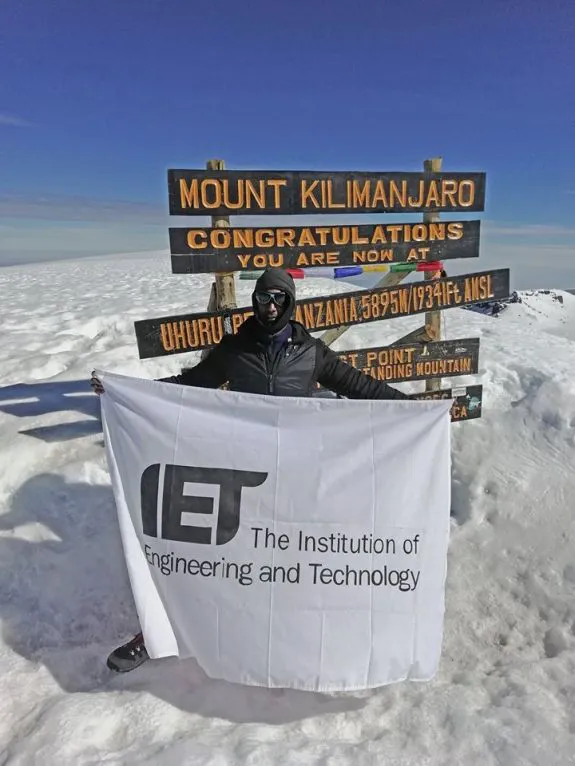
IET Mauritius Network : atop Mount Kilimanjaro
The IET Archives has also created a montage film made up of clips from our film collections. It features some of our great members talking about their work and clips from past lectures.
Bibliography
Appleyard, Rollo The History of the Institution of Electrical Engineers (1871-1931). London: IEE, 1939
Reader, W.J A History of the Institution of Electrical Engineers 1871-1971. London: IEE, 1987
IEE NEWS membership publications
Journal of The Institution of Electrical Engineers
